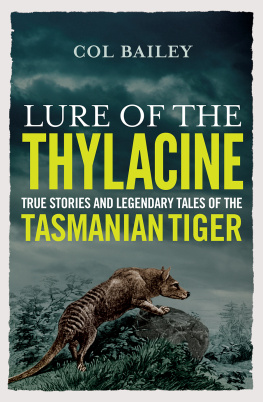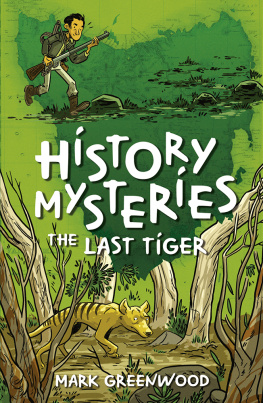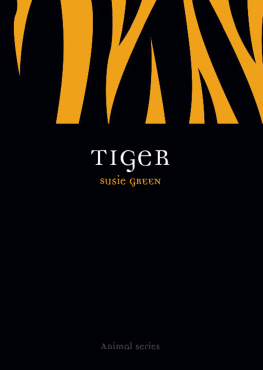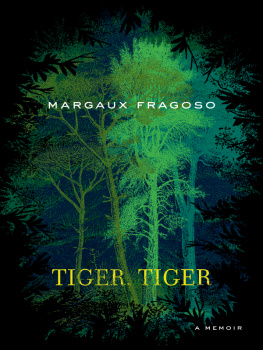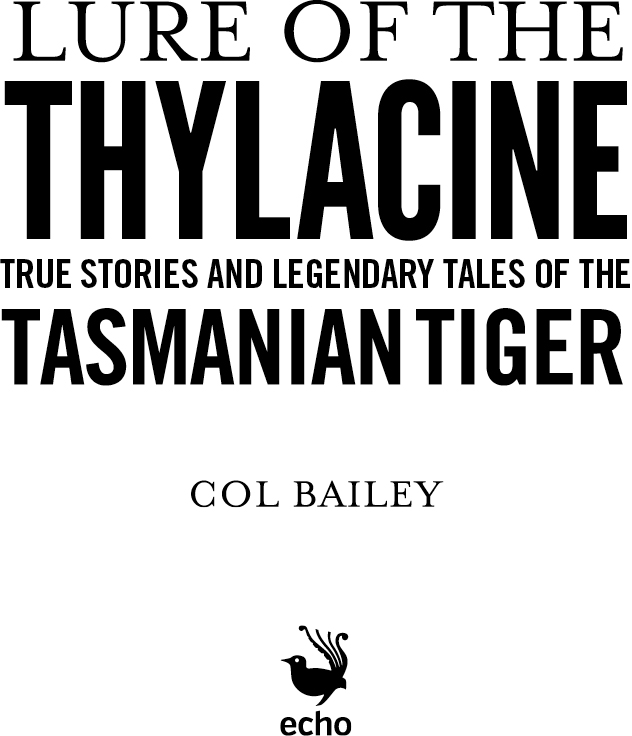For Lexia
Foreword
Professor Mike Archer, University of New South Wales
The thylacine, once Australias top marsupial predator, has many devotees, and one of the most loyal enthusiasts of this now-believed-extinct beast is Col Bailey. He is absolutely convinced, and not without good reason, that this once prolific animal, intentionally slaughtered in the thousands in the 1800s and early 1900s, is in fact with us still. With all my heart, I hope he is right.
Cols collation of tales in the pages that follow is, and has been for me, totally addictive. I doubt that anyone who starts to read these accounts will be able to put the book down before finishing. So it should come with a warning that, once opened, this book will require an allocation of at least three otherwise task-free hours before you will be able to focus on anything else. Some of these stories may make you fume with anger at what we did to this unfortunate animal, while others will likely make you weep, for despite how incredibly forgiving these creatures were, we ruthlessly tore them apart. Cols account of Reg Triggs Lucy gave me heartache, while other stories involving personal sightings entice us to share Cols unshakable conviction that the thylacine must surely still be out there roaming the remote bushland of Tasmania, perhaps permitting us a second chance.
As I read these captivating stories, it occurred to me that Col and I have been trying to deal with the tragedy of the thylacines decline in curiously similar ways we have both been gathering and interpreting previously overlooked fragments of ancient information. His obsession began in 1967, the same year I returned to Australia to research the paleontological history of the thylacine based on fossils. Cols invaluable and far more elusive fragments are the memories of the hunters and bushmen, most of them long since departed, who knew the thylacine far better than any of the scientists of their time. He has used their experiences and observations to blend a distinctly unique patchwork quilt of support and understanding about this magnificent marsupial.
The fragments I and others have sought in addition to fossils have been pieces of DNA that can be recovered from almost all of the preserved juvenile specimens, skins and skulls sequestered in museums around the world, mini-genetic arks patiently awaiting the day when we become proficient enough to use these as a tool to de-extinct thylacines back into the world again. But just as Cols albeit rich compilation of bushmens wisdom contains gaps in what we should know about the thylacine, the challenge for molecular biologists hoping to recreate a whole thylacine from DNA fragments may be comparable gaps in knowledge about this animals genetic recipe.
But of course bridging these gaps may all be unnecessary if Cols conviction that its still out there is correct. As he confessed in his last book, Shadow of the Thylacine , he actually saw one in 1995 in the Weld River Valley in south-west Tasmania, just after daybreak on a cool autumn morning, and ironically, as he points out, this was nine years after the thylacine was declared officially extinct.
Col began writing up these bushmens and trappers tales in a biweekly series in the Derwent Valley Gazette between 1995 and 2005, a pastime that increasingly became an incurable obsession. In the gathering of these stories he has added a vast amount to the little previously known in addressing uncertainties about the biology and ecology of an animal that scientists neglected to document before the last captive individual died in 1936.
Regardless, it would be wrong to think that Cols obsession entirely consumed his life post 1967. Like the best of the colonial bushmen he admires, he has long been a lover of all things wild. When not pursuing or writing about the thylacine, he has, in his time, been an avid canoeist, bushwalker, explorer and also a marathon race walker. As he notes in his previous book, his earliest aspiration as a youngster was to become a vet, an ambition unfortunately thwarted by family circumstances at the time. Regardless, he has accomplished much in resolutely keeping alive the conviction, backed by his own experience, that living, breathing thylacines are still out there in the wilds of the island state.
When Col and I went bushwalking in south-east Tasmania in 2001, we chose paths thylacines were known to have frequented, such as the bushland within the enchanting Styx forests near Maydena and the vast highland plains of the Mount Field National Park, where international tourists had recently reported seeing two thylacines loping across the snow-laden buttongrass sedge land.
As we walked through the bush and I listened to the wisdom of this man, his optimism proved irresistibly contagious as it has to so many others. So, we made an agreement. He promised that if he caught one alive, he would grab a small bit of tissue before releasing the animal so we could have some fresh DNA to work with. In return, I promised that if we managed to clone a thylacine before he found one, wed release the first one near his backyard so he could have the exquisite pleasure of finding a live one in the bush. Whatever comes first, finding a live survivor or whipping up a reconstituted thylacine, both of us fully intend to keep our promises.
Until that exciting time arrives, I commend to you, lucky reader, this wonderful compilation of stories which Col has presented, complete with his own perceptive commentaries that enrich our understanding about these tales from the old trappers and bushmen. Although many of these stories are unverifiable because they were, after all, personal experiences that cant be scientifically tested, they need to be cherished because at the moment theyre pretty much all weve got to remind us of what it was that we so carelessly let slip out of sight.
I do so hope that Col is right about its continued survival, and that as a result he will be the first to fulfil the mutual agreement we made that day while sitting on a log deep in a wilderness that was once the kingdom of the mighty thylacine.
Professor Michael Archer
School of Biological, Earth and Environmental Sciences
University of New South Wales
Introduction
My first book, Tiger Tales , originated from discussions with an old Tasmanian trapper, Reg Trigg. I met Reg in 1980, and he generously shared a wealth of stories about the Tasmanian tiger. Comprising both anecdotes and verified historical accounts, these stories spanned over 100 years, during which time the thylacine graduated from being seen as a despised sheep-killer to its modern-day status of magnificent survivor.
The first edition of Tiger Tales was published in 2001, following the stories original publication as a biweekly series in the Derwent Valley Gazette . Over time Tiger Tales has become a sought-after collectors item that in recent years has commanded a figure many times its original cover price. Although this edition contains a selection of the original tales, I have also included additional information and new stories.
An ever-growing band of Tasmanian tiger devotees contends that the animal continues to exist, despite the unwavering stance taken by the scientific fraternity that it is extinct. I am not in any way attempting to challenge the scientists reasoning, as no conclusive proof has emerged to prove otherwise since the last known thylacine died in the Hobart Zoo in 1936. Nevertheless, I reserve the right to offer my personal opinion.

